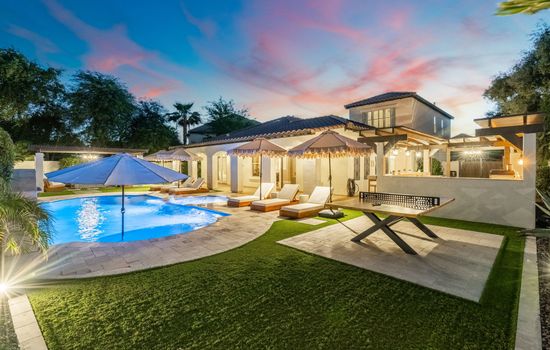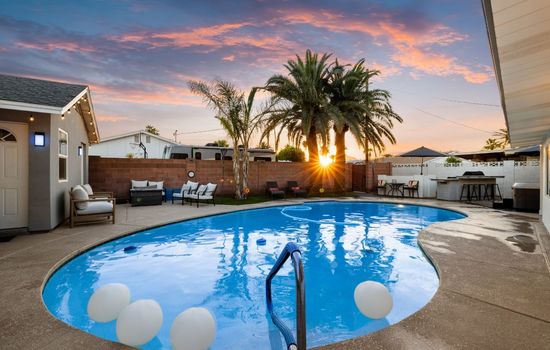There is no visitor center or public access to Hohokam Pima National Monument. The site is not open for visits.
There is no entrance fee at Hohokam Pima National Monument because it is not open to the public.
From Phoenix, take Interstate 10 east towards Sacaton, passing through the protected area near Mile Marker 170, a poignant glimpse into ancient civilization.
Parking available at main entrance off Interstate 10 and secondary entrance off State Route 87. Designated RV parking for vehicles up to 40 feet; no overnight parking outside campsites. No parking fees mentioned. Motorcycle parking also available.
Accessibility & permits
Emergency
- Cell service availability:None
Information not accurate?
Help us improve by making a suggestion.
Hohokam Pima National Monument, located within the Gila River Indian Community near Sacaton, Arizona, is a site steeped in ancient history and cultural significance, though it remains inaccessible to the public. This protected area encompasses the archaeological site known as Snaketown, a village that thrived from approximately 300 BCE to 1200 CE. The landscape here is a vast expanse of arid desert, punctuated by the silent remnants of a bygone era.
Despite the lack of public access, the surrounding area offers a glimpse into the lives of the Hohokam people. The nearby Huhugam Heritage Center, with its meticulous exhibits on tribal history and archaeology, serves as a window into the past. For a more immersive experience, visitors can head to the Casa Grande Ruins National Monument in Coolidge, Arizona, where artifacts from Snaketown are on display.
While the monument itself is off-limits, the drive through the area is a surreptitious glimpse into its boundaries; a portion of Interstate 10 traverses the monument, offering a fleeting view of the desert landscape. The Gila River Indian Reservation, home to the monument, is a place of rich cultural heritage, with its own unique flora and fauna that thrive in the arid environment.
For those seeking to delve deeper, the Huhugam Heritage Center and the Casa Grande Ruins provide a comprehensive look at the historical and cultural context of the Hohokam Pima National Monument. Though it may not be a destination for traditional sightseeing, it is a place that whispers tales of an ancient civilization, inviting travelers to appreciate its hidden history and the preserved legacy of the Hohokam people.
- Area (mi²)
- 2.6
- Established year
- 1972
Top 3 Facts about Hohokam Pima National Monument
The ancient village of Snaketown, located 48 kilometers southeast of Phoenix, Arizona, was inhabited from about 300 BCE to 1200 CE and featured a complex irrigation system for crops, including beans, maize, and squash, highlighting the advanced agricultural practices of the Hohokam people.
Surrounded by the arid beauty of the Arizona landscape, this ancient site is flanked by blooming cacti and volcanic rock formations. The area is home to a diverse array of wildlife, including desert tortoises, Gila monsters, and a variety of bird species such as the cactus wren and the Gila woodpecker. The unique flora includes the iconic saguaro cactus and paloverde trees, which thrive in this desert environment. Although the site itself is not open to the public, the surrounding natural beauty and nearby hiking trails offer a compelling reason to explore this rich and historic region.
Surrounded by the arid landscape of the Arizona desert, this ancient site is set near the Gila River, where the sun-baked earth meets the occasional burst of life from ephemeral lakes and reservoirs. The area’s unique geological features include intermittent lakes that appear and disappear with the seasons, a testament to the dynamic and harsh yet beautiful environment that has shaped human habitation here for centuries. Temperatures soar during the day, dropping sharply at night, adding to the dramatic allure of this desert oasis.
Family programs
- Junior Ranger
- Ranger-led Tours
- Self-guided Tours
- Workshops & Hands-on Activities
- Living History & Cultural Demos
- Scavenger Hunts
- Night Sky & Astronomy
- Family Camping & Overnight
- Arts & Crafts
Travel Tips
Plan Ahead
Plan a few days in late winter to avoid heat; visit nearby Huhugam Heritage Center for cultural insights. No on-site access, so photograph from Interstate 10 and explore surrounding areas. Pack meals and stay at nearby Lost Dutchman State Park.
Pack Appropriately
Pack sun protection, ample water, and layered clothing for desert heat and cooler nights. Bring hiking shoes, first-aid kit, and navigation tools. For longer stays, include camping gear, stove, and extra food. Check the season for specific needs.
Respect Wildlife
Maintain a safe distance from wildlife, avoid feeding or disturbing them. Stay on marked trails to prevent soil erosion and respect fragile vegetation. Visit during cooler hours to minimize impact on active animals. Carry out all trash and keep the area pristine.
Stay Informed
Stay informed about weather, fire restrictions, and park rules. Exercise caution on trails, near ledges, and water. Bring plenty of water and let someone know your plans. For emergencies, call (520) 258-7200.
Seasons
Visit in spring, March to May, when temperatures range from 60 to 85°F. Mild weather and vibrant wildflowers set the stage for Native American celebrations, arts and crafts festivals, and exceptional birdwatching. Ideal for hiking, photography, and guided tours amidst blooming desert landscapes.
Summer brings scorching temperatures (often over 100°F) but clear skies ideal for stargazing and night sky viewing. Enjoy water activities like kayaking and fishing on the Gila River, or visit Rawhide, an 1880 frontier town replica, for authentic cowboy experiences. June to August.
Visit in fall for mild temperatures (70s-80s°F) and clear skies, but be aware that this site remains inaccessible to the public due to its sensitive nature. Instead, explore the Huhugam Heritage Center nearby, which offers insights into the Hohokam culture year-round. No special autumn events are available.
Visit in winter (December to February) for mild temperatures (50s-70s°F) and clear skies, but be aware that the site remains inaccessible, with no visible remnants above ground. Instead, immerse yourself in the surrounding cultural heritage through local museums and communities.
Information not accurate?
Help us improve by making a suggestion.
Where to stay
Frequently Asked Questions
Ready to dive into what Hohokam Pima National Monument has to offer? Let’s tackle some of the burning questions you might have as you plan your visit!
-
The closest city to the monument is Phoenix, Arizona, which is about 20 miles northwest of the site. It is also near Sacaton, Arizona, within the Gila River Indian Reservation.
-
Dogs must be on a leash no longer than 6 feet at all times. They are allowed along roads, hiking trails, wilderness areas, campgrounds, and picnic areas, but they must be restrained or leashed.
-
You cannot visit this site as it is not open to the public. The area is protected by the Gila River Indian Reservation and there is no public access. However, you can drive through the monument on Interstate 10 or visit the Huhugam Heritage Center to learn more about the Hohokam people.
-
You cannot visit the site as it is not open to the public due to its sensitive nature. The area, which includes the ancient village of Snaketown, is located on the Gila River Indian Reservation and is protected by the Gila River Indian Community. A portion of Interstate 10 does pass through the monument, but there is no public access or visitor facilities.



